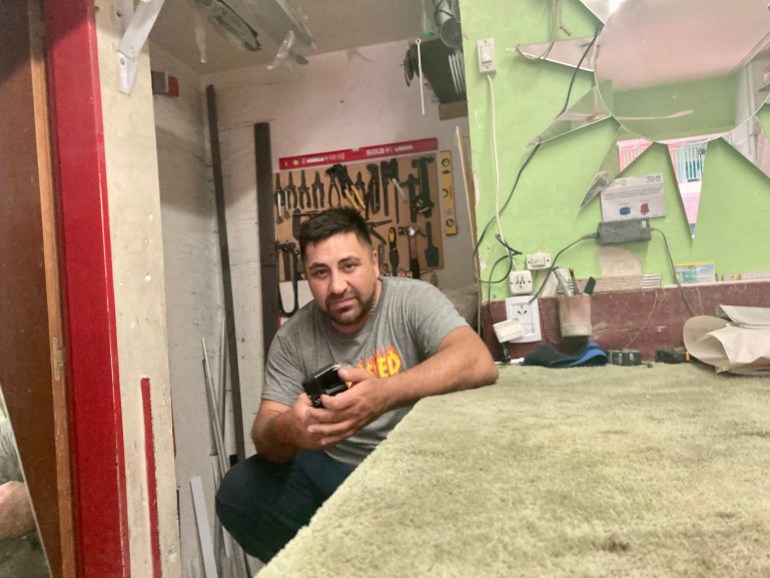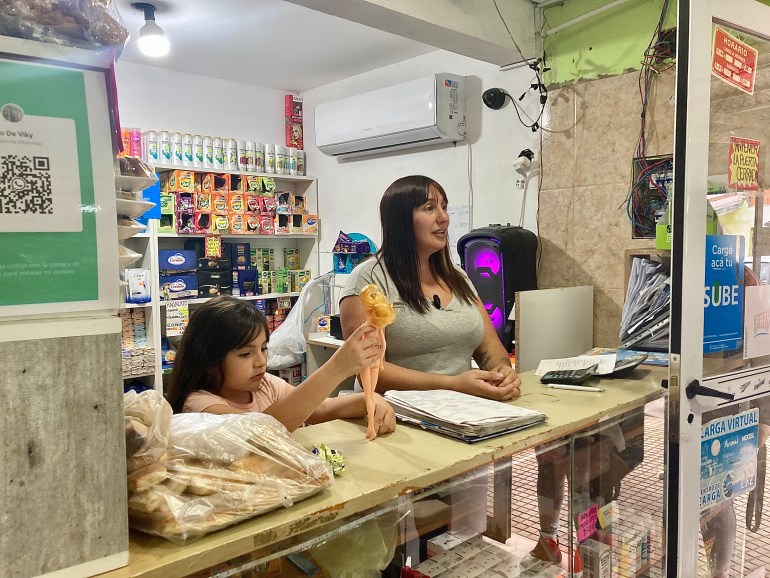Buenos Aires, Argentina – At times like this in Argentina, prices are one thing you can’t guarantee.
Just ask Diego Barrera and Claudio Cayeta, who own a small aluminum and glass shop in the Palermo neighborhood of Buenos Aires. The business partners spent two weeks last month navigating a virtual paralysis due to the volatile economic situation gripping the country, unable to find the materials they needed, and as a result unable to prices to their customers.
“Our providers won’t give us anything because the [United States] dollar is rising every day, so they don’t want to lose money,” said Barrera, 43, whose stock has dwindled as uncertainty around them grows.
“I understand, because the same thing happens to me,” he said. “I’ve already lost money on the prices I quoted some of my clients.”
This reality has become alarmingly common in Argentina, where the economy is unraveling at an accelerated pace. The rising value of the US dollar is actually a measure of the plunging value of the Argentine peso, which fell as much as 25 percent on the black market during the month of April. On April 25, it hit a record low, grazing 500 pesos for one US dollar at the unofficial rate, the rate most often used as a benchmark for the average Argentine because currency controls limit how much they can buy at the official exchange rate.
With inflation over 104 percent in the past 12 months, according to official statistics, it’s getting harder and harder to know what anything is worth, let alone the budget for everyday things. Food prices alone rose an average of 10 percent in March compared to the previous month in the Greater Buenos Aires region — fruits and vegetables up about 15 percent; eggs 25 percent.
Commodities, such as those Barrera and Cayeta work with, are also impossible to predict because prices rise and fall with the value of the currency. The price of glass rose 10 percent in mid-April, Barrera said, and his supplier recommended a second increase by the same amount two weeks later.

All this has led to a climate of political instability during an election year. The highly unpopular President Alberto Fernandez formally announced that he would not seek re-election, later blaming rumors and speculation from right-wing politicians.
In a tweet, Economy Minister Sergio Massa said he would “use all the tools of the state to manage this situation,” and that included redefining the terms of a controversial deal with the International Monetary Fund (IMF) to pay back a $44 billion loan. .
After the Central Bank of Argentina intervened on April 25 and traded bonds, in violation of the agreement with the IMF, the unofficial exchange rate plummeted to 460 pesos per US dollar. Argentina also announced it would pay for imports from China in the yuan instead of the dollar, a move that will help safeguard its greenback reserves.
But on the street, the damage from volatility has already been done.
‘Hunting for the best price’

“Don’t ask me how I adapt, but somehow I manage to do it,” said Emiliano Espindola, 47, as he mixed feta cheese with herbs, tomatoes and cucumber in the back of a Middle Eastern takeaway shop . He’s a chef in Belgrano, an affluent part of Buenos Aires where, he noted, people may have been insulated from the week’s financial volatility. But not him, a blue-collar worker who commutes an hour and a half by bus from the outskirts of Buenos Aires to care for his teenage daughter. Espindola starts doing odd jobs as a construction worker to make ends meet.
“I’m just always looking for the best price, but at the same time to lower my costs,” he said. “Overall, the economic pain is across the board. The cost of the bus ticket goes up every month. And we’re not even talking about groceries yet. One week you have one prize, the next week another.”
For Yolanda Gonzalez, a 53-year-old nurse and the main breadwinner in her home, the solution is to reduce the number of meals her family eats. They cannot change their clothes and limit their outings to those that are free, such as a sunny afternoon in the park, accompanied by the traditional yerba mate infusion. “You work 24 hours, and it’s not enough, you work 30 days, and it’s not enough,” she said.
Argentina has spent most of the past 12 years in either recession or stagnation, said economist Martin Kalos, a director of the Buenos Aires-based firm EPyCA Consultores.
The latest 2022 figures show that nearly 40 percent of the population is affected by poverty, and one in two children lives below the poverty line, according to the national census collector. This crisis dates back four decades, with the country’s productive capacity gradually eroding and the gap between rich and poor widening.
“Argentina urgently needs to restore its growth, but first it needs an economic stabilization that it has not been able to achieve,” said Kalos. “Argentina’s inflation rates are not only above 100 percent, they are accelerating and we don’t know how close they will get to 130 or 150 percent next year.”
The Argentine government has turned to price-fixing to try and soften the blow of ravenous inflation by making deals with major supermarket chains. But even these programs have their limitations: offerings vary from store to store, and smaller grocers are out of price-fixing and must stock their shelves with wholesalers, making it impossible for them to compete with the cheapest price on offer.
Cheaper alternatives

The incessant rise in prices means cheaper brands of products are flooding the market.
Victoria Alcober holds out a handful of “unofficial” cigarette packs that she began offering at her small grocery store in the city of Ensenada, about an hour’s drive from the capital, Buenos Aires. It was her own customers who informed her about the packs, which cost about a third of the price of the larger, better-known brands.
“As a trader, you have to look for it because that’s what people are buying these days,” she said. “There are a lot of alternative brands using them now because of all the price increases.”
Argentines are also looking for political alternatives. Presidential and parliamentary elections are due in October, and the deepening recession has reinvigorated radical positions, including abolishing the peso altogether and using the US dollar as official currency, a proposal particularly promoted by the Libertarian candidate Javier Miley.
Barrera, the owner of the glass shop, is deeply frustrated and exhausted by the day-to-day financial uncertainty and the inability of the political class to contain the chaos. But he fears that such extreme positions as the dollarization of the economy will only make matters worse, and he fears that good leadership alternatives are not forthcoming. “The iron is hot now,” he said. “They know they’re going to get burned.”